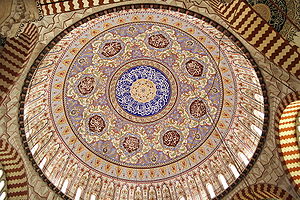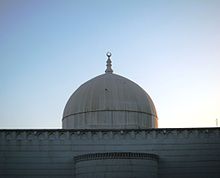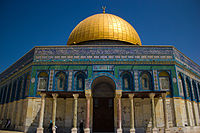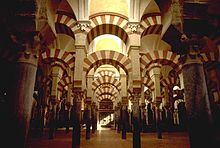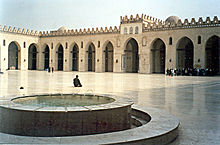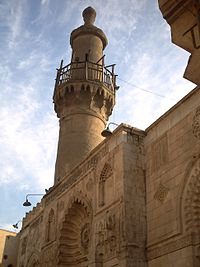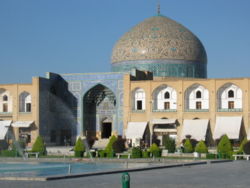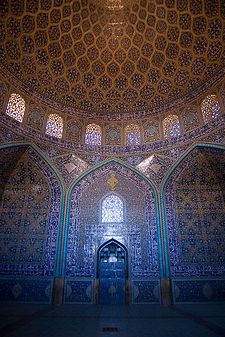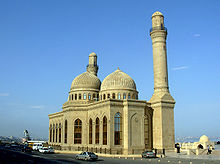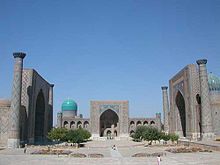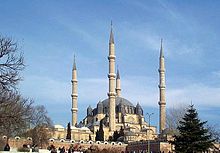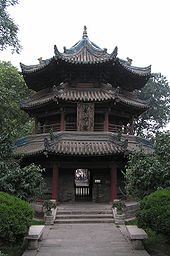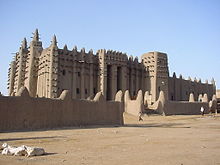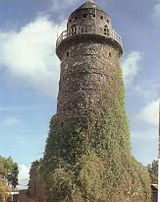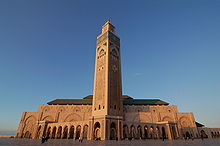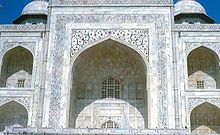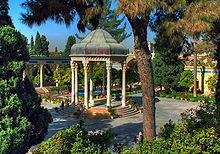- Islamic architecture
-
Islamic architecture encompasses a wide range of both secular and religious styles from the foundation of Islam to the present day, influencing the design and construction of buildings and structures in Islamic culture. The principal Islamic architectural types are: the Mosque, the Tomb, the Palace and the Fort. From these four types, the vocabulary of Islamic architecture is derived and used for buildings of lesser importance such as public baths, fountains and domestic architecture.[1][2]
Contents
Influences
A specifically recognizable Islamic architectural style emerged soon after Muhammad's time, inspired by Islam with addition of localized adaptations of the former Sassanid and Byzantine models, the Germanic Visigoths in Spain also made a big contribution to Islamic architecture. They invented the Horseshoe arch in Spain and used them as one of their main architectural features, After the moorish invasion of Spain in 711 AD the form was taken by the Ummayyads who accentuated the curvature of the horseshoe.[3] The Dome of the Rock (Qubbat al-Sakhrah) in Jerusalem (691) is one of the most important buildings in all of Islamic architecture, marked by a strong Byzantine influence (mosaic against a gold background, and a central plan that resembles that of the Church of the Holy Sepulchre, although the church itself was renovated several times in the Islamic period[4]), but already bearing purely Islamic elements, such as the great epigraphic frieze. It featured interior vaulted spaces, a circular dome, and the use of stylized repeating decorative arabesque patterns. The desert palaces in Jordan and Syria (for example, Mshatta, Qasr Amra, and Khirbat al-Mafjar) served the caliphs as living quarters, reception halls, and baths, and were decorated to promote an image of royal luxury.
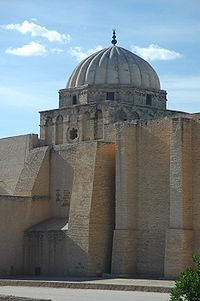 Dome of the mihrab in the Great Mosque of Kairouan also known as the Mosque of Uqba, in Kairouan, Tunisia
Dome of the mihrab in the Great Mosque of Kairouan also known as the Mosque of Uqba, in Kairouan, Tunisia
Religious and civic architecture were developed under the Umayyads, when new concepts and new plans were put into practice. Thus, the “Arab plan,” with court and hypostyle prayer hall, truly became a functional type with the construction of the Umayyad Mosque, or the Great Mosque of Damascus (completed in 715 by caliph Al-Walid I)[5] on top of the ancient temple of Jupiter and in place of the basilica of St. John the Baptist, the most sacred site in the city. This building served as a point of reference for builders (and for art historians) for the birth of the Arab plan, as Byzantine Christian.
The Abbasid dynasty (750 A.D.- 1258[6]) witnessed the movement of the capital from Damascus to Baghdad, and then from Baghdad to Samarra. The shift to Baghdad influenced politics, culture, and art. The Great Mosque of Samarra, once the largest in the world, was built for the new capital. Other major mosques built in the Abbasid Dynasty include the Mosque of Ibn Tulun in Cairo, Abu Dalaf in Iraq, the great mosque in Tunis. Abbasid architecture in Iraq as exemplified in the Fortress of Al-Ukhaidir (c.775-6) demonstrated the "despotic and the pleasure-loving character of the dynasty" in its grand size but cramped living quarters.[7]
The Great Mosque of Kairouan (in Tunisia), considered as the ancestor of all the mosques in the western Islamic world,[8] is one of the best preserved and most significant examples of early great mosques. Founded in 670 AD, it dates in its present form largely from the Aghlabid period (9th century).[9] The Great Mosque of Kairouan is constituted of a massive square minaret, a large courtyard surrounded by porticos and a huge hypostyle prayer hall covered on its axis by two cupolas.[8] The Great Mosque of Samarra in Iraq, completed in 847 AD, combined the hypostyle architecture of rows of columns supporting a flat base above which a huge spiraling minaret was constructed.
The Hagia Sophia in Istanbul also influenced Islamic architecture. When the Ottomans captured the city from the Byzantines, they converted the basilica to a mosque (now a museum) and incorporated Byzantine architectural elements into their own work (e.g. domes). The Hagia Sophia also served as a model for many Ottoman mosques such as the Shehzade Mosque, the Suleiman Mosque, and the Rüstem Pasha Mosque.
Distinguishing motifs of Islamic architecture have always been ordered repetition, radiating structures, and rhythmic, metric patterns. In this respect, fractal geometry has been a key utility, especially for mosques and palaces. Other significant features employed as motifs include columns, piers and arches, organized and interwoven with alternating sequences of niches and colonnettes.[10] The role of domes in Islamic architecture has been considerable. Its usage spans centuries, first appearing in 691 with the construction of the Dome of the Rock, and recurring even up until the 17th century with the Taj Mahal. As late as the 19th century, Islamic domes had been incorporated into Western architecture.[11][12]
History
There are few buildings dating to the era of Prophet Muhammad, one example is: Juatha mosque in Saudi Arabia.
Rashidun Caliphate
Rashidun Caliphate (632-661) was the first state to use Islamic Architecture, sought the first use of Islamic Forts, Administration systems (Dar al-Imara) and the first foundation of Islamic cities (Basra, Kufa and Fostat).
Umayyad Caliphate
Umayyad Empire (661-750), in the Umayyad era many new elements were included to the Islamic architecture: Minarates, Arabisque, Mosaic, Luxury palaces.
Moorish architecture
Construction of the Great Mosque at Cordoba (now a cathedral known as the Mezquita) beginning in 785 CE marks the beginning of Islamic architecture in the Iberian peninsula and North Africa (see Moors). The mosque is noted for its striking interior arches. Moorish architecture reached its peak with the construction of the Alhambra, the magnificent palace/fortress of Granada, with its open and breezy interior spaces adorned in red, blue, and gold. The walls are decorated with stylized foliage motifs, Arabic inscriptions, and arabesque design work, with walls covered in glazed tile. There other, smaller, survivals such as the Bab Mardum in Toledo, or the caliphal city of Medina Azahara. Moorish architecture has its roots deeply established in the Arab tradition of architecture and design established during the era of the first Caliphate of the Umayyads in the Levant circa 660AD with its capital Damascus having very well preserved examples of fine Arab Islamic design and geometrics, including the carmen, which is the typical Damascene house, opening on the inside with a fountain as the house's centre piece.
Even after the completion of the Reconquista, Islamic influence had a lasting impact on the architecture of Spain. In particular, medieval Spaniards used the Mudéjar style, highly influence Islamic design. One of the best examples of the Moors' lasting impact on Spanish architecture is the Alcázar of Seville.
Abbasid Caliphate
Abbasid Caliphate (750-1513), Islamic Architecture peaked in the Abbasid era, cities such as Baghdad, Damascus, Aleppo were of the largest cities ever.[13]
Break Away Kingdoms:
Fatimid architecture
In architecture, the Fatimids followed Tulunid techniques and used similar materials, but also developed those of their own. In Cairo, their first congregational mosque was al-Azhar mosque ("the splendid") founded along with the city (969–973), which, together with its adjacent institution of higher learning (al-Azhar University), became the spiritual center for Ismaili Shia. The Mosque of al-Hakim (r. 996–1013), an important example of Fatimid architecture and architectural decoration, played a critical role in Fatimid ceremonial and procession, which emphasized the religious and political role of the Fatimid caliph. Besides elaborate funerary monuments, other surviving Fatimid structures include the Aqmar Mosque (1125) as well as the monumental gates for Cairo's city walls commissioned by the powerful Fatimid emir and vizier Badr al-Jamali (r. 1073–1094).
Mamluk architecture
The reign of the Mamluks (1250-1517 AD) marked a breathtaking flowering of Islamic art which is most visible in old Cairo. Religious zeal made them generous patrons of architecture and art. Trade and agriculture flourished under Mamluk rule, and Cairo, their capital, became one of the wealthiest cities in the Near East and the center of artistic and intellectual activity. This made Cairo, in the words of Ibn Khaldun, "the center of the universe and the garden of the world", with majestic domes, courtyards, and soaring minarets spread across the city.
The architectural identity of Mamluk religious monuments stems from the major purpose that individuals erected their own memorials, therefore adding a high degree of individuality. Each building reflected the patron’s individual tastes, choices, and name. Mamluk architecture is oftentimes categorized more by the reigns of the major sultan, than a specific design. Interestingly, the mamluk elite were often more knowledgeable in the art of buildings than many historians.[14] Since the Mamluks had both wealth and power, the overall moderate proportions of Mamluk architecture—compared to Timurid or classical Ottoman styles—is due to the individual decisions of patrons who preferred to sponsor multiple projects. The sponsors of the mosques of Baibars, al-Nasir Muhammad, Faraj, al-Mu’ayyad, Barsbay, Qaitbay and al-Ghawri all preferred to build several mosques in the capital rather than focusing on one colossal monument. Patrons used architecture to strengthen their religious and social roles within the community.
While the organization of Mamluk monuments varied, the funerary dome and minaret were constant leitmotifs. These attributes are prominent features in a Mamluk mosque's profile and were significant in the beautification of the city skyline. In Cairo, the funerary dome and minaret were respected as symbols of commemoration and worship.[14] Patrons used these visual attributes to express their individuality by decorating each dome and minaret with distinct patterns. Patterns carved on domes ranged from ribs and zigzags to floral and geometric star designs. The funerary dome of Aytimish al-Bajasi and the mausoleum dome of Qaitbay's sons reflect the diversity and detail of Mamluk architecture. Therefore the creativity of Mamluk builders was effectively emphasized with these leitmotifs.
Expanding on the Fatimids concept of street-adjusted mosque facades, the Mamluks developed their architecture to enhance street vistas. In addition, new aesthetic concepts and architectural solutions were created to reflect their assumed role in history. By 1285 the essential features of Mamluk architecture were already established in the complex of Sultan Qalawan. However, it took three decades for the Mamluks to create a new and distinct architecture. By 1517, the Ottoman conquest brought Mamluk architecture to an end without a term of decadence.[14]
The Mamluk utilized chiaroscuro and dappled light effects in their buildings. Mamluk history is divided into two periods based on different dynastic lines: the Bahri Mamluks (1250–1382) of Qipchaq Turkic origin from southern Russia, named after the location of their barracks on the Nile and the Burji Mamluks (1382–1517) of Caucasian Circassian origin, who were quartered in the citadel. The Bahri reign defined the art and architecture of the entire Mamluk period. Mamluk decorative arts—especially enameled and gilded glass, inlaid metalwork, woodwork, and textiles—were prized around the Mediterranean as well as in Europe, where they had a profound impact on local production. The influence of Mamluk glassware on the Venetian glass industry is only one such example.
The reign of Baybars's ally and successor, Qala’un (r. 1280–90), initiated the patronage of public and pious foundations that included madrasas, mausolea, minarets, and hospitals. Such endowed complexes not only ensured the survival of the patron's wealth but also perpetuated his name, both of which were endangered by legal problems relating to inheritance and confiscation of family fortunes. Besides Qala’un's complex, other important commissions by Bahri Mamluk sultans include those of al-Nasir Muhammad (1295–1304) as well as the immense and splendid complex of Hasan (begun 1356).
The Burji Mamluk sultans followed the artistic traditions established by their Bahri predecessors. Mamluk textiles and carpets were prized in international trade. In architecture, endowed public and pious foundations continued to be favored. Major commissions in the early Burji period in Egypt included the complexes built by Barquq (r. 1382–99), Faraj (r. 1399–1412), Mu’ayyad Shaykh (r. 1412–21), and Barsbay (r. 1422–38).
In the eastern Mediterranean provinces, the lucrative trade in textiles between Iran and Europe helped revive the economy. Also significant was the commercial activity of pilgrims en route to Mecca and Medina. Large warehouses, such as the Khan al-Qadi (1441), were erected to satisfy the surge in trade. Other public foundations in the region included the mosques of Aqbugha al-Utrush (Aleppo, 1399–1410) and Sabun (Damascus, 1464) as well as the Madrasa Jaqmaqiyya (Damascus, 1421).
In the second half of the 15th century, the arts thrived under the patronage of Qa’itbay (r. 1468–96), the greatest of the later Mamluk sultans. During his reign, the shrines of Mecca and Medina were extensively restored. Major cities were endowed with commercial buildings, religious foundations, and bridges. In Cairo, the complex of Qa’itbay in the Northern Cemetery (1472–74) is the best known and admired structure of this period. Building continued under the last Mamluk sultan, Qansuh al-Ghawri (r. 1501–17), who commissioned his own complex (1503–5); however, construction methods reflected the finances of the state. Though the Mamluk realm was soon incorporated into the Ottoman empire (1517), Mamluk visual culture continued to inspire Ottoman and other Islamic artistic traditions.
Styles
Persian architecture
Main article: Persian architectureThe Lotfallah Mosque, in Isfahan, Iran. When finished in 1618, this mosque became the private mosque of the Safavid royalty.
The Islamic conquest of Persia in the 7th century led early Islamic architects to borrow and adopt some traditions and ways of the fallen Persian empire. Islamic architecture thus borrows heavily from Persian architecture and in many ways can be called an extension and further evolution of Persian architecture.
In Iran and the north of India, the Tahirids, Samanids, Ghaznavids, and Ghurids struggled for power in the 10th century, and art was a vital element of this competition. Great cities were built, such as Nishapur and Ghazni, and the construction of the Great Mosque of Isfahan (which would continue, in fits and starts, over several centuries) was initiated. Funerary architecture was also cultivated.
Under the Seljuqs the “Iranian plan” of mosque construction appears for the first time. Lodging places called khans, or caravanserai, for travellers and their animals, or caravansarais, generally displayed utilitarian rather than ornamental architecture, with rubble masonry, strong fortifications, and minimal comfort.[15] Seljuq architecture synthesized various styles, both Iranian and Syrian, sometimes rendering precise attributions difficult. Another important architectural trend to arise in the Seljuk era is the development of mausolea including the tomb tower such as the Gunbad-i-qabus (circa 1006-7) (showcasing a Zoroastrian motif) and the domed square, an example of which is the tomb of the Samanids in the city of Bukhara (circa 943).[16]
The Il-Khanate period provided several innovations to dome-building that eventually enabled the Persians to construct much taller structures. These changes later paved the way for Safavid architecture. The pinnacle of Il-Khanate architecture was reached with the construction of the Soltaniyeh Dome (1302–1312) in Zanjan, Iran, which measures 50 m in height and 25 m in diameter, making it the 3rd largest and the tallest masonry dome ever erected.[17] The thin, double-shelled dome was reinforced by arches between the layers.[18] The tomb of Öljeitü in Soltaniyeh is one of the greatest and most impressive monuments in Iran, despite many later depredations.
Iranian architecture and city planning also reached an apogee under the Timurids, in particular with the monuments of Samarkand, marked by extensive use of exterior ceramic tiles and muqarnas vaulting within.
The renaissance in Persian mosque and dome building came during the Safavid dynasty, when Shah Abbas, in 1598 initiated the reconstruction of Isfahan, with the Naqsh-e Jahan Square as the centerpiece of his new capital.[19] The distinct feature of Persian domes, which separates them from those domes created in the Christian world or the Ottoman and Mughal empires, was the colorful tiles, with which they covered the exterior of their domes, as they would on the interior. These domes soon numbered dozens in Isfahan, and the distinct, blue- colored shape would dominate the skyline of the city. Reflecting the light of the sun, these domes appeared like glittering turquoise gem and could be seen from miles away by travelers following the Silk road through Persia. This very distinct style of architecture was inherited to them from the Seljuq dynasty, who for centuries had used it in their mosque building, but it was perfected during the Safavids when they invented the haft- rangi, or seven- colour style of tile burning, a process that enabled them to apply more colours to each tile, creating richer patterns, sweeter to the eye.[20] The colours that the Persians favoured where golden, white and turquoise patterns on a dark- blue background.[21] The extensive inscription bands of calligraphy and arabesque on most of the major buildings where carefully planned and executed by Ali Reza Abbasi, who was appointed head of the royal library and Master calligrapher at the Shah's court in 1598,[22] while Shaykh Bahai oversaw the construction projects. Reaching 53 meters in height, the dome of Masjed-e Shah (Shah Mosque) would become the tallest in the city when it was finished in 1629. It was built as a double- shelled dome, with 14 m spanning between the two layers, and resting on an octagonal dome chamber.[23]
Persian-style mosques are also characterized by their tapered brick pillars, large arcades and arches each supported by several pillars. In South Asia, elements of Hindu architecture were employed, but were later superseded by Persian designs.[24]
Azerbaijani architecture
The Islamic conquest of Persia in the 7th century also helped Islamic architecture to flourish in Azerbaijan.[25][26] The country became home of Nakchivan and Shirvan-Absheron architecture schools. An example of the first direction in the Azerbaijani Islamic architecture is the mausoleum of Yusuf, built in 1162.[27]
The Shirvan-Absheron school unlike Nakchivan style used stones instead of the bricks in the construction. At the same characteristics of this trend were the asymmetry and stone carving, which includes famous landmarks like Palace of the Shirvanshahs.
Turkistan (Timurid) architecture
Timurid architecture is the pinnacle of Islamic art in Central Asia. Spectacular and stately edifices erected by Timur and his successors in Samarkand and Herat helped to disseminate the influence of the Ilkhanid school of art in India, thus giving rise to the celebrated Mughal school of architecture. Timurid architecture started with the sanctuary of Ahmed Yasawi in present-day Kazakhstan and culminated in Timur's mausoleum Gur-e Amir in Samarkand. The style is largely derived from Persian architecture. Axial symmetry is a characteristic of all major Timurid structures, notably the Shah-e Zendah in Samarkand and the mosque of Gowhar Shad in Mashhad. Double domes of various shapes abound, and the outsides are perfused with brilliant colors.They can be more good than bad.
Ottoman architecture
The standard plan of Ottoman architecture was inspired in part by the example of Hagia Sophia in Constantinople/Istanbul, Ilkhanid works like Oljeitu Tomb and earlier Seljuk and Anatolian Beylik monumental buildings and their own original innovations. The most famous of Ottoman architects was (and remains) Mimar Sinan, who lived for approximately one hundred years and designed several hundreds of buildings, of which two of the most important are Süleymaniye Mosque in Istanbul and Selimiye Mosque in Edirne. Apprentices of Sinan later built the famous Blue Mosque in Istanbul and the Taj Mahal in India.
The most numerous and largest of mosques exist in [Turkey], which obtained influence from Byzantine, Persian and Syrian-Arab designs. Turkish architects implemented their own style of cupola domes.[24] For almost 500 years Byzantine architecture such as the church of Hagia Sophia served as models for many of the Ottoman mosques such as the Shehzade Mosque, the Suleiman Mosque, and the Rüstem Pasha Mosque.
The Ottomans mastered the technique of building vast inner spaces confined by seemingly weightless yet massive domes, and achieving perfect harmony between inner and outer spaces, as well as light and shadow. Islamic religious architecture which until then consisted of simple buildings with extensive decorations, was transformed by the Ottomans through a dynamic architectural vocabulary of vaults, domes, semidomes and columns. The mosque was transformed from being a cramped and dark chamber with arabesque-covered walls into a sanctuary of esthetic and technical balance, refined elegance and a hint of heavenly transcendence.
Indo-Islamic architecture
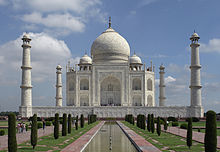 The Taj Mahal in Agra, India built by Mughal Emperor Shah Jahan as a mausoleum for his wife, represents the pinnacle of Mughal Islamic architecture in India and is one of the most recognisable buildings in the world.
The Taj Mahal in Agra, India built by Mughal Emperor Shah Jahan as a mausoleum for his wife, represents the pinnacle of Mughal Islamic architecture in India and is one of the most recognisable buildings in the world.
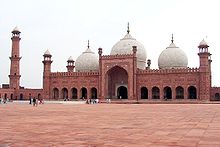 The Badshahi Masjid, literally the 'Royal Mosque', was built in 1674 by Aurangzeb. It is one of Lahore's best known landmarks, and epitomizes the beauty and grandeur of the Mughal era.
The Badshahi Masjid, literally the 'Royal Mosque', was built in 1674 by Aurangzeb. It is one of Lahore's best known landmarks, and epitomizes the beauty and grandeur of the Mughal era.
Another distinctive sub-style is the architecture of the Mughal Empire in South Asia in the 16th century and a fusion of Arabic, Central Asian and Persian elements with the local Hindu architecture. The most famous examples of Mughal architecture are the series of imperial mausolea, which started with the pivotal Tomb of Humayun, but is best known for the Taj Mahal, completed in 1648 by emperor Shah Jahan in memory of his wife Mumtaz Mahal who died while giving birth to their 14th child. The extensive use of precious and semiprecious stones as inlay and the vast quantity of white marble required nearly bankrupted the empire.[dubious ] The Taj Mahal is completely symmetrical except for Shah Jahan's sarcophagus, which is placed off center in the crypt room below the main floor. This symmetry extended to the building of an entire mirror mosque in red sandstone to complement the Mecca-facing mosque place to the west of the main structure. A famous example of the charbagh style of Mughal garden is the Shalimar Gardens in Lahore, where the domeless Tomb of Jahangir is also located. The Red Fort in Dehli and Agra Fort are huge castle-like fortified palaces, and the abandoned city of Fatehpur Sikri, 26 miles west of Agra, was built for Akbar in the late 16th century.
Sino-Islamic architecture
 Hui people who have also migrated to the south such as this Darunaman Mosque, locating in Chiang Rai province, Thailand shows a great mixture between Chinese and Islamic architecture.
Hui people who have also migrated to the south such as this Darunaman Mosque, locating in Chiang Rai province, Thailand shows a great mixture between Chinese and Islamic architecture.
The first Chinese mosque was established in the 7th century during the Tang Dynasty in Xi'an. The Great Mosque of Xi'an, whose current buildings date from the Ming Dynasty, does not replicate many of the features often associated with traditional mosques. Instead, it follows traditional Chinese architecture. Some Chinese mosques in parts of western China were more likely to incorporate minarets and domes while eastern Chinese mosques were more likely to look like pagodas.[28]
An important feature in Chinese architecture is its emphasis on symmetry, which connotes a sense of grandeur; this applies to everything from palaces to mosques. One notable exception is in the design of gardens, which tends to be as asymmetrical as possible. Like Chinese scroll paintings, the principle underlying the garden's composition is to create enduring flow; to let the patron wander and enjoy the garden without prescription, as in nature herself.
Chinese buildings may be built with either red or grey bricks, but wooden structures are the most common; these are more capable of withstanding earthquakes, but are vulnerable to fire. The roof of a typical Chinese building is curved; there are strict classifications of gable types, comparable with the classical orders of European columns.
Most mosques have certain aspects in common with each other however as with other regions Chinese Islamic architecture reflects the local architecture in its style. China is renowned for its beautiful mosques, which resemble temples. However in western China the mosques resemble those of the Arab World, with tall, slender minarets, curvy arches and dome shaped roofs. In northwest China where the Chinese Hui have built their mosques, there is a combination of eastern and western styles. The mosques have flared Buddhist style roofs set in walled courtyards entered through archways with miniature domes and minarets.[29]
Sahelian-Islamic architecture
In West Africa, Islamic merchants played a vital role in the Western Sahel region since the Kingdom of Ghana. At Kumbi Saleh, locals lived in domed-shaped dwellings in the king's section of the city, surrounded by a great enclosure. Traders lived in stone houses in a section which possessed 12 beautiful mosques (as described by al-bakri), one centered on Friday prayer.[30] The king is said to have owned several mansions, one of which was sixty-six feet long, forty-two feet wide, contained seven rooms, was two stories high, and had a staircase; with the walls and chambers filled with sculpture and painting.[31] Sahelian architecture initially grew from the two cities of Djenné and Timbuktu. The Sankore Mosque in Timbuktu, constructed from mud on timber, was similar in style to the Great Mosque of Djenné.
Somali-Islamic architecture
Main article: Somali architectureThe peaceful introduction of Islam in the early medieval era of Somalia's history brought Islamic architectural influences from Arabia and Persia, which stimulated a shift from drystone and other related materials in construction to coral stone, sundried bricks, and the widespread use of limestone in Somali architecture. Many of the new architectural designs such as mosques were built on the ruins of older structures, a practice that would continue over and over again throughout the following centuries.[32] Concordant with the ancient presence of Islam in the Horn of Africa region, mosques in Somalia are some of the oldest on the entire continent. One architectural feature that made Somali mosques distinct from other mosques in Africa were minarets.
For centuries, Arba Rukun (1269), the Friday mosque of Merca (1609) and Fakr ad-Din (1269) were, in fact, the only mosques in East Africa to have minarets.[33] Fakr ad-Din, which dates back to the Mogadishan Golden Age, was built with marble and coral stone and included a compact rectangular plan with a domed mihrab axis. Glazed tiles were also used in the decoration of the mihrab, one of which bears a dated inscription. The 13th century Al Gami University consisted of a rectangular base with a large cylindrical tower architecturally unique in the Islamic world.
Shrines to honor Somali patriarchs and matriarchs evolved from ancient Somali burial customs. In Southern Somalia the preferred medieval shrine architecture was the Pillar tomb style while the North predominantly built structures consisting of domes and square plans.
Interpretation
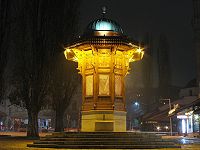 The Sebilj is a pseudo-Ottoman style wooden fountain in the centre of Baščaršija square in Sarajevo, Bosnia.
The Sebilj is a pseudo-Ottoman style wooden fountain in the centre of Baščaršija square in Sarajevo, Bosnia.
Common interpretations of Islamic architecture include the following: The concept of God or Allah's infinite power is evoked by designs with repeating themes which suggest infinity. Human and animal forms are rarely depicted in decorative art as God's work is considered to be matchless. Foliage is a frequent motif but typically stylized or simplified for the same reason. Arabic Calligraphy is used to enhance the interior of a building by providing quotations from the Qur'an. Islamic architecture has been called the "architecture of the veil" because the beauty lies in the inner spaces (courtyards and rooms) which are not visible from the outside (street view). Furthermore, the use of grandiose forms such as large domes, towering minarets, and large courtyards are intended to convey power.
Architecture Forms and Styles of mosques and buildings in Muslim countries
Forms
Many forms of Islamic architecture have evolved in different regions of the Islamic world. Notable Islamic architectural types include the early Abbasid buildings, T-Type mosques, and the central-dome mosques of Anatolia. The oil-wealth of the 20th century drove a great deal of mosque construction using designs from leading modern architects.
Arab-plan or hypostyle mosques are the earliest type of mosques, pioneered under the Umayyad Dynasty. These mosques are square or rectangular in plan with an enclosed courtyard and a covered prayer hall. Historically, because of the warm Mediterranean and Middle Eastern climates, the courtyard served to accommodate the large number of worshippers during Friday prayers. Most early hypostyle mosques have flat roofs on top of prayer halls, necessitating the use of numerous columns and supports.[34] One of the most notable hypostyle mosques is the Mezquita in Córdoba, Spain, as the building is supported by over 850 columns.[35] Frequently, hypostyle mosques have outer arcades so that visitors can enjoy some shade. Arab-plan mosques were constructed mostly under the Umayyad and Abbasid dynasties; subsequently, however, the simplicity of the Arab plan limited the opportunities for further development, and as a result, these mosques gradually fell out of popularity.[34]
The Ottomans introduced central dome mosques in the 15th century and have a large dome centered over the prayer hall. In addition to having one large dome at the center, there are often smaller domes that exist off-center over the prayer hall or throughout the rest of the mosque, where prayer is not performed.[36] This style was heavily influenced by the Byzantine religious architecture with its use of large central domes.[34]
Iwan
Sehan
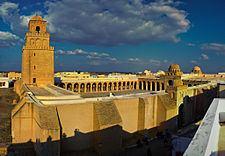 The Great Mosque of Kairouan, with a large courtyard—sehan surrounded by arcades, located in Kairouan, Tunisia.
The Great Mosque of Kairouan, with a large courtyard—sehan surrounded by arcades, located in Kairouan, Tunisia.
The traditional Islamic courtyard, a sehan in Arabic (ar: صحن), is found in secular and religious structures.
- When within a residence or other secular building is a private courtyard and walled garden. It is used for: the aesthetics of plants, water, architectural elements, and natural light; for cooler space with fountains and shade, and source of breezes into the structure, during summer heat; and a protected and proscribed place where the women of the house need not be covered in the hijab clothing traditionally necessary in public.
- A sehan—courtyard is in within almost every mosque in Islamic architecture. The courtyards are open to the sky and surrounded on all sides by structures with halls and rooms, and often a shaded semi-open arcade. Sehans usually feature a centrally positioned ritual cleansing pool under an open domed pavilion called a howz . A mosque courtyard is used for performing ablutions, and a 'patio' for rest or gathering.
Gardens
Main article: Islamic GardensThe Qur'an uses the garden as an analogy for paradise and Islam came to have a significant influence on garden design. The concept of paradise garden was commonly used the Persian gardens, as well as Charbagh garden of Mughal architecture.
Arabesque
An element of Islamic art usually found decorating the walls and window screens of mosques and Muslim homes and buildings, the arabesque is an elaborate application of repeating geometric forms that often echo the forms of plants, shapes and sometimes animals (specifically birds). The choice of which geometric forms are to be used and how they are to be formatted is based upon the Islamic view of the world. To Muslims, these forms, taken together, constitute an infinite pattern that extends beyond the visible material world.[37] To many in the Islamic world, they in fact symbolize the infinite, and therefore uncentralized, nature of the creation of the one God ("Allah" in Arabic). Furthermore, the Islamic Arabesque artist conveys a definite spirituality without the iconography of Christian art. Arabesque is used in mosques and building around the Muslim world, and it is a way of decorating using beautiful, embellishing and repetitive Islamic art instead of using pictures of humans and animals (which is forbidden Haram in Islam).
Calligraphy
Arabic calligraphy is associated with geometric Islamic art (the Arabesque) on the walls and ceilings of mosques as well as on the page. Contemporary artists in the Islamic world draw on the heritage of calligraphy to use calligraphic inscriptions or abstractions in their work.
Instead of recalling something related to the reality of the spoken word, calligraphy for the Muslim is a visible expression of spiritual concepts. Calligraphy has arguably become the most venerated form of Islamic art because it provides a link between the languages of the Muslims with the religion of Islam. The holy book of Islam, al-Qur'ān, has played a vital role in the development of the Arabic language, and by extension, calligraphy in the Arabic alphabet. Proverbs and complete passages from the Qur'an are still active sources for Islamic calligraphy.
Elements of Islamic style
Islamic architecture may be identified with the following design elements, which were inherited from the first mosque built byr hall (originally a feature of the Masjid al-Nabawi).
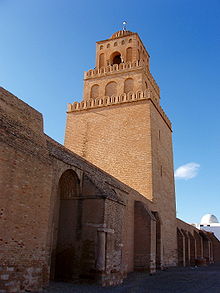 Minaret of the Great Mosque of Kairouan regarded as the oldest surviving minaret in the world, situated in Kairouan, Tunisia.
Minaret of the Great Mosque of Kairouan regarded as the oldest surviving minaret in the world, situated in Kairouan, Tunisia.
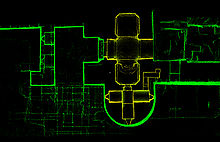 Plan view of Bab al-Barqiyya along Ayyubid Wall. Located close to one of Cairo's main modern traffic arteries, al-Azhar Street, the Fatimid-era Bab al-Barqiyya fortified gate was constructed with interlocking volumes that surrounded the entrant in such a way as to provide greater security and control than typical city wall gates.
Plan view of Bab al-Barqiyya along Ayyubid Wall. Located close to one of Cairo's main modern traffic arteries, al-Azhar Street, the Fatimid-era Bab al-Barqiyya fortified gate was constructed with interlocking volumes that surrounded the entrant in such a way as to provide greater security and control than typical city wall gates.
- Minarets or towers (these were originally used as torch-lit watchtowers, as seen in the Great Mosque of Damascus; hence the derivation of the word from the Arabic nur, meaning "light"). The minaret of the Great Mosque of Kairouan in Tunisia is considered as the oldest surviving minaret in the world.[38] It has the shape of a square massive tower of three superimposed sections.[38]
- A four-iwan plan, with three subordinate halls and one principal one that faces toward Mecca
- Mihrab or prayer niche on an inside wall indicating the direction to Mecca. This may have been derived from previous uses of niches for the setting of the Torah scrolls in Jewish synagogues (see Torah ark) or the haikal of Coptic churches.
- Pishtaq is the formal gateway to the iwan, usually the main prayer hall of a mosque, a vaulted hall or space, walled on three sides, with one end entirely open; a Persian term for a portal projecting from the facade of a building, usually decorated with calligraphy bands, glazed tilework, and geometric designs.[39][40]
- Iwans to intermediate between different pavilions.
- The use of Islamic geometric patterns and foliage based arabesques.
- The use of mocárabe and muqarnas, a unique Arabic/Islamic space-enclosing system, for the decoration of domes, minarets and portals, as used at the Alhambra.
- The use of decorative Islamic calligraphy instead of pictures which were haram (forbidden) in mosque architecture. Note that in secular architecture, human and animal representation was indeed present.
- The use of bright color, if the style is Persian or Indian (Mughal); paler sandstone and grey stones are preferred among Arab buildings. Compare the Registan complex of Uzbekistan to the Al-Azhar University of Cairo.
- Focus both on the interior space of a building and the exterior[citation needed]
Islamic architects
Ghazi Mikdashi http://www.ghazimikdashi.com
See also
- Mosque
- Kasbah
- Madrasah
- Caravanserai
- Sebil (drinking water facility)
- Well House
- Turbah
References
- ^ Copplestone, p.149
- ^ http://www.islamonline.net/servlet/Satellite?c=Article_C&cid=1158658332974&pagename=Zone-English-ArtCulture%2FACELayout A Tour of Architecture in Islamic Cities
- ^ http://www.green-man-of-cercles.org/articles/the_development_of_the_horseshoe_arch_in_christian_spain.pdf
- ^ The Church of the Holy Sepulchre , Martin Biddle. p.68
- ^ Hillenbrand, Robert. Islamic Art and Architecture, Thames & Hudson World of Art series; 1999, London. ISBN 978050020305
- ^ Gruber, World of Art
- ^ Hillenbrand (1999).
- ^ a b John Stothoff Badeau and John Richard Hayes, The Genius of Arab civilization: source of Renaissance. Taylor & Francis. 1983. p. 104
- ^ Great Mosque of Kairouan (Qantara mediterranean heritage)
- ^ Tonna (1990), pp.182-197
- ^ Grabar, O. (2006) p.87
- ^ Ettinghausen (2003), p.87
- ^ Societies, Networks, and Transitions: A Global History: To 1500, Craig A. Lockard. pp. 281-82
- ^ a b c Behrens-Abouseif, Doris. Cairo of the Mamluks : A History of Architecture and Its Culture. New York: Macmillan, 2008.
- ^ Hillenbrand, p.109
- ^ Hillenbrand, p.100.
- ^ http://www.iranreview.org/content/view/2280/51/
- ^ http://www.iranicaonline.org/articles/domes
- ^ Savory, Roger; Iran under the Safavids, p. 155
- ^ Blake, Stephen P.; Half the World, The Social Architecture of Safavid Isfahan, 1590- 1722, p. 143- 144
- ^ Canby, Sheila R.; Shah Abbas, The Remaking of Iran, p. 30.
- ^ Canby, Sheila R.; Shah Abbas, The Remaking of Iran, p. 36.
- ^ Hattstein M., Delius P.; Islam, Art and Architecture; p. 513- 514
- ^ a b "Islam", The New Encyclopedia Britannica (2005)
- ^ Journal Islam Today N° 14-1417H/1996
- ^ Virtual Azerbaijan: Azerbaijan's History
- ^ "Архитектура исламских мечетей". anysite.ru. http://anysite.ru/publication/islam. Retrieved 3 August 2010.
- ^ Cowen, Jill S. (July/August 1985). "Muslims in China: The Mosque". Saudi Aramco World. pp. 30–35. http://www.saudiaramcoworld.com/issue/198504/muslims.in.china-the.mosques.htm. Retrieved 2006-04-08.
- ^ Saudi Aramco World, July/August 1985 , page 3035
- ^ Historical Society of Ghana. Transactions of the Historical Society of Ghana, The Society, 1957, pp81
- ^ Davidson, Basil. The Lost Cities of Africa. Boston: Little Brown, 1959, pp86
- ^ Culture and customs of Somalia - Mohammed Abdullahi Diriye pg 102
- ^ Studies in Islamic history and civilization By David Ayalon pg 370
- ^ a b c Hillenbrand, R. "Masdjid. I. In the central Islamic lands". In P.J. Bearman, Th. Bianquis, C.E. Bosworth, E. van Donzel and W.P. Heinrichs. Encyclopaedia of Islam Online. Brill Academic Publishers. ISSN 1573-3912.
- ^ "Religious Architecture and Islamic Cultures". Massachusetts Institute of Technology. http://web.mit.edu/4.614/www/handout02.html. Retrieved 2006-04-09.
- ^ "Vocabulary of Islamic Architecture". Massachusetts Institute of Technology. Archived from the original on 2005-11-24. http://web.archive.org/web/20051124083425/http://ocw.mit.edu/OcwWeb/Architecture/4-614Religious-Architecture-and-Islamic-CulturesFall2002/LectureNotes/detail/vocab-islam.htm#islam6. Retrieved 2006-04-09.
- ^ Sheila R. Canby, Islamic art in detail, page 26. Harvard University Press, 2005.
- ^ a b Titus Burckhardt, Art of Islam, Language and Meaning: Commemorative Edition. World Wisdom. 2009. p.128
- ^ Dictionary of Islamic architecture: Pishtaq archnet.org.
- ^ Pishtaq Britannica.com.
Further reading
- Fletcher, Banister; Cruickshank, Dan, Sir Banister Fletcher's a History of Architecture, Architectural Press, 20th edition, 1996 (first published 1896). ISBN 0750622679. Cf. Part Three.
External links
- Architecture of IRAN during Islamic times
- ARCHITECTURE OF ISLAM by Takeo Kamiya (Half in English and half in Japanese)
- Fatimid-era Ayyubid Wall of Cairo Digital Media Archive (creative commons-licensed photos, laser scans, panoramas), data from a Aga Khan Foundation/CyArk research partnership
Categories:- Islamic architecture
- Islamic art
- Islamic architectural elements
Wikimedia Foundation. 2010.



